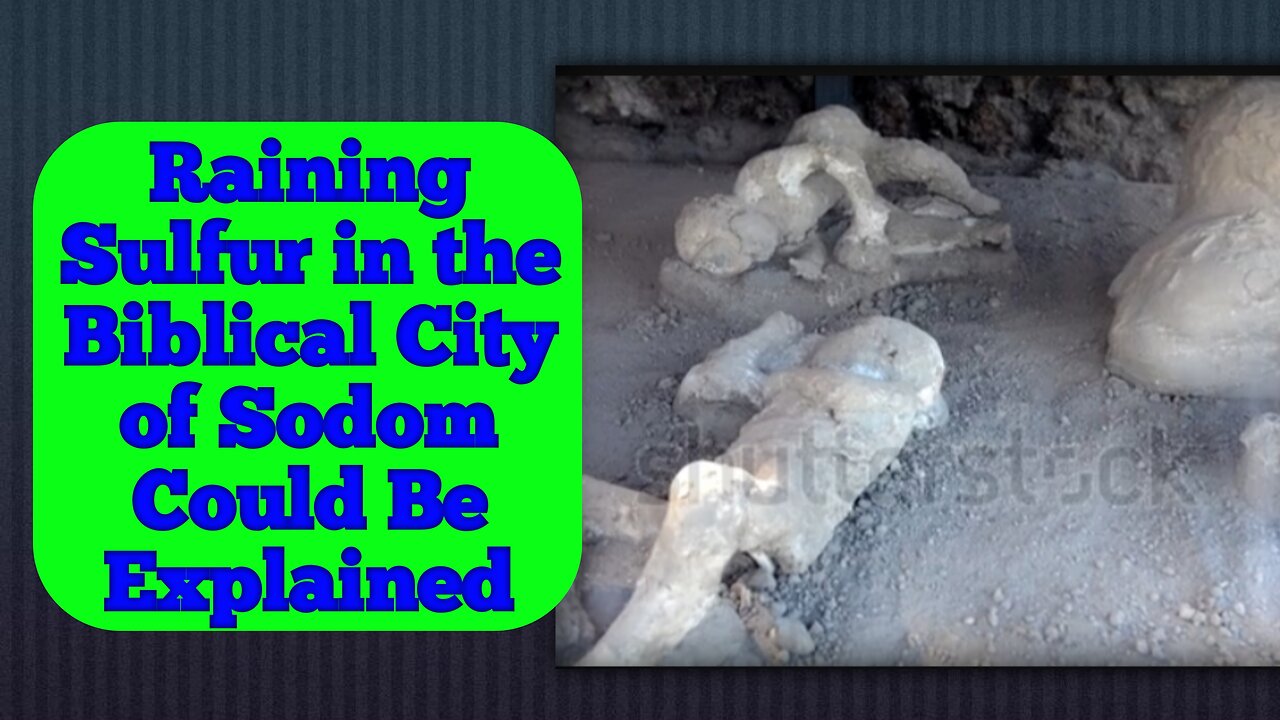Premium Only Content

Raining Sulfur in the Ancient City of Sodom Could Be Clarified by an Impact Event
Raining Sulfur in the Ancient City of Sodom Could Be Clarified by an Impact Event
By: Briana Brownell
Around 3,600 years ago, the vibrant city-state of Tall el-Hammam thrived in the Jordan Valley near the Dead Sea, enjoying 1,500 years of prosperity. However, the city met a catastrophic fate, and the neighboring farmland became salt-contaminated, transforming a once-fertile region into an overnight wasteland. Humans abandoned the area for at least five centuries, leaving researchers perplexed about the cataclysm's cause.
Now, a rather extraordinary explanation has emerged — one that aligns with an age-old narrative many are familiar with. Some historians propose that the disaster bears resemblance to the biblical account of the destruction of Sodom, one of the cities in the Old Testament purportedly obliterated by a divine force.
The destruction of Tall el-Hammam was indeed profound. The city was encircled by a formidable mudbrick wall, 13 feet thick and 100 feet high, most of which had been sheared away. Amid the ruins, remnants of molten pottery and precious metals were discovered, all shrouded in ash heavily laden with salt.
Unusual substances were also unearthed: shocked quartz, a material prevalent in nuclear bomb testing areas; minuscule iron and silica-containing spheres known as spherules; and nano-scale diamonds. For these peculiar materials to materialize, temperatures exceeding 2,000 degrees Celsius, akin to the surface temperature of a small red dwarf star, must have prevailed.
So, what unfolded? These telltale signs pointed to a remarkably high-energy, high-temperature event. Scientists surmise that it was a cosmic airburst resulting from a sizable meteor detonating in the sky above the city.
Cosmic airbursts are not uncommon but are typically small-scale events. When a meteor enters Earth's atmosphere, friction with air molecules causes it to heat up. Upon penetrating the increasingly dense lower atmosphere, the meteor can become superheated and explode.
This is precisely what researchers propose transpired at Tall el-Hammam. The extreme temperatures render it improbable that an Earth-based phenomenon such as an earthquake or volcanic eruption was responsible. Furthermore, the technological capabilities of the time were insufficient to orchestrate such a large-scale explosion. Hence, scientists deduced that a meteor, likely causing a cosmic airburst, best aligned with the available data.
The research team discerned an intriguing similarity between the cosmic airburst scenario and the biblical tale of Sodom's destruction. Key elements of the story, including the descent of fire and brimstone from the sky, appear consistent with what eyewitnesses might have observed during a cosmic airburst event. Consequently, many archaeologists and historians are now pondering whether the annihilation of Tall el-Hammam might have inspired this ancient biblical narrative. It appears that a 3,600-year-old enigma may have found a resolution.
-
 1:57:13
1:57:13
MyronGainesX
11 hours agoFormer Fed Explains Sting That Led To The Murder Of A State Trooper
68.9K20 -
 3:56:27
3:56:27
Due Dissidence
17 hours agoNewsom ROASTED For Pod Save Interview, Candace Owens CALLS OUT Elon, Ian Carroll RATIOES Israel Post
68K52 -
 2:16:17
2:16:17
TheSaltyCracker
9 hours agoLooters Descend on LA ReeEEeE Stream 01-12-25
138K281 -
 40:32
40:32
Man in America
14 hours agoRockefeller Medicine COLLAPSES as God's Natural Healing Takes Over w/ Angie Tomky
47.8K18 -
 2:03:30
2:03:30
Nerdrotic
11 hours ago $6.62 earnedMysteries of Egypt with The Brothers of the Serpent | Forbidden Frontier #087
50.7K3 -
 2:29:27
2:29:27
vivafrei
19 hours agoEp. 245: Los Angeles ON FIRE! Gavin Newsom FOR JAIL? Trump SENTENCED! Pardons & MORE! VIva & Barnes
200K307 -
 5:32:42
5:32:42
Nobodies Live
10 hours ago $5.29 earnedNobodiesLive - Rumble Music TEST STREAM 2.0
65.8K2 -
 3:40:10
3:40:10
EricJohnPizzaArtist
9 hours agoAwesome Sauce PIZZA ART LIVE Ep. #30: Classic Gaming!
45.8K7 -
 1:18:42
1:18:42
Josh Pate's College Football Show
11 hours ago $0.92 earnedSEC Dominance Over | National Title Thoughts | Miami QB & DC Moves | Wrong About the Playoff?
36.1K4 -
 LIVE
LIVE
Vigilant News Network
15 hours agoIvermectin & Fenbendazole Cancer Secrets Revealed w/ Dr. William Makis | Media Blackout
851 watching